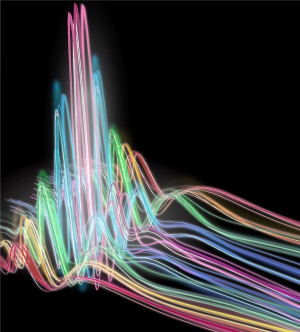
Chemical bonds can be probed with fast, laser-like X-ray pulses (illustrated).
T. Popmintchev & B. Baxley/JILA/Univ. Colorado
The pressurized, cylindrical chamber fits in the palm of Margaret Murnane’s hand. Yet out of one end of the device comes an X-ray beam that packs almost as much punch as the light generated by massive particle accelerators.
Murnane and Henry Kapteyn, both physicists at JILA in Boulder, Colorado, a joint institute of the University of Colorado and the US National Institute of Standards and Technology, have reported the first tabletop source of ultra-short, laser-like pulses of low energy, or ‘soft’, X-rays. The light, capable of probing the structure and dynamics of molecules, was previously available only at large, billion-dollar national facilities such as synchrotrons or free-electron lasers, where competition for use of the equipment is fierce. But the report by Murnane, Kapteyn and their colleagues, published in the 8 June issue of Science (T. Popmintchev et al. Science 336, 1287–1291; 2012), suggests that the devices might soon lie within the grasp of a university laboratory budget. “For us, it’s incredible that we can do this at all in a tabletop system,” says Murnane. “Three years ago, people would have said ‘only large facilities can do that’.”
Murnane and Kapteyn, a husband-and-wife team who also head the Boulder-based company KMLabs, already sell a similar tabletop source of extreme-ultraviolet light. Murnane thinks that a future soft X-ray source should cost about US$1 million, and hopes that its relatively low cost and small size will open up X-ray studies for materials scientists, biologists and others. The beams generated by the device could, for instance, help materials scientists to make better solar materials by tracking the paths of electrons through solar cells, and might allow chemists to trace the ultrafast dynamics of photosynthesis and catalysis. “This is something people have been waiting for for a very long time,” says Oleg Shpyrko, a physicist at the University of California, San Diego. Shpyrko often waits months to get his experiments accepted at the Advanced Photon Source, a synchrotron at Argonne National Laboratory in Illinois, and must then fly his students halfway across the country to do the work.
ftp://mail.ihim.uran.ru/localfiles/486172a.pdf
